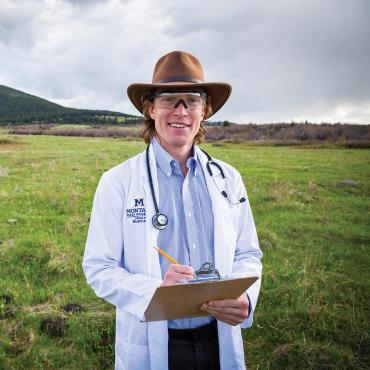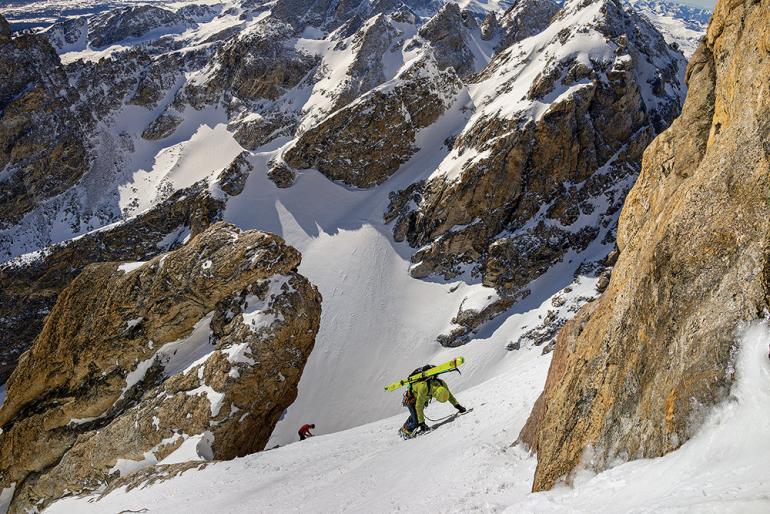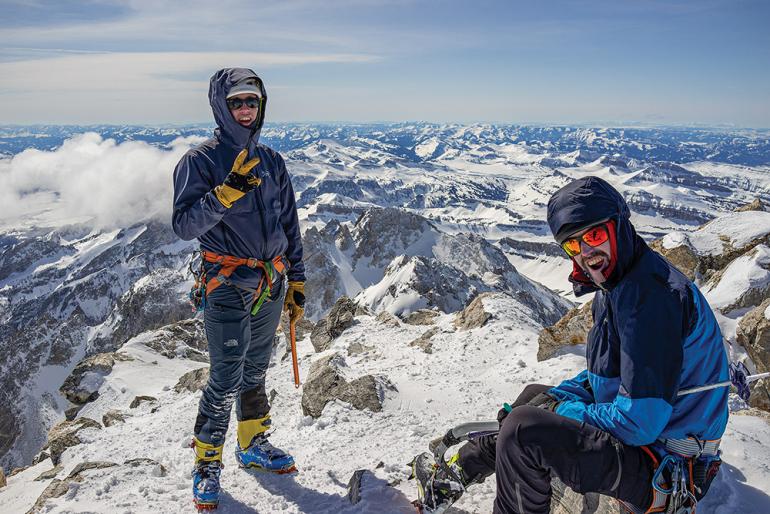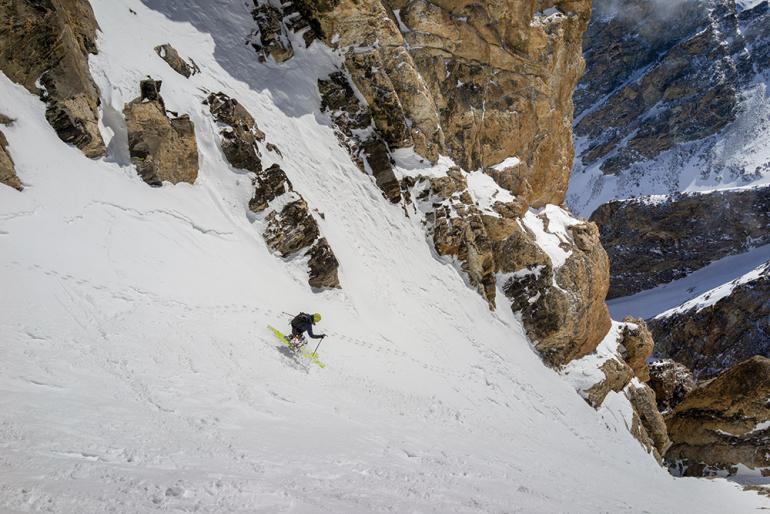Flash & Grab
Skiing the Grand in a push from Bozeman.
There’s nothing like the sound of skis crunching on firm snow in a dark forest very early in the morning. Actually, you could say it was the middle of the night—we left the trailhead at 12:30am, but our journey was already well underway at that point. On a whim to claim the Grand Teton as one of Bozeman’s “local” mountains, we decided to drive down there and ski it, then drive back, without stopping, or sleeping. Be careful what you wish for.
Stoke was high as we strode through the fir trees whispering gently in a nighttime downslope breeze. Maybe too high—in our haste, as we crossed Bradley Lake, we aimed slightly too far north toward the summertime trail from Lupine Meadows. This led us up a steep refrozen slope, where Owen and I were jealous of Taylor’s ski crampons. Aggravated by the unnecessary challenge, we switched to bootpacking and pulled on tree branches to prevent us from slipping backward. After a detour that probably added three hours to our ascent, we finally arrived in Garnet Canyon, still shrouded in darkness. Perhaps the added time was a blessing in disguise.
We smirked at each other, donned our crampons, and pulled out our second ice tools. Going up.
The sun crested as we reached the base of the Teepee Glacier, about halfway up the mountain. Or rather, the sky began to lighten, though a high layer of dense clouds encapsulating the range’s highest peaks blocked out any inkling of a sunrise. Not quite the morale-boost we were looking for. Nonetheless, we could see to the top of the glacier, where a col at the base of the Stettner Couloir indicated our next water stop. The glacier took much longer to climb than suggested by its foreshortened view from below, but even after an hour of slogging, the clouds still hadn’t lifted.
At this point it seemed like our outing would end too soon—we were merely 100 feet below the cloud ceiling and none of us wanted to climb into the unknown without visibility. We all knew what the others were thinking without exchanging any words. I threw on my biggest puffy, laid my backpack on the ground behind a large boulder, and curled into a ball on top of it. I closed my eyes for what felt like a few seconds, but when I awoke, 20 minutes had passed. The dense blanket of grey was dissolving into a web of wispy tendrils, and I could feel the sunlight warming my body. We smirked at each other, donned our crampons, and pulled out our second ice tools. Going up.
Despite the shady aspect, I was huffing, sweating, and shedding layers after five minutes of steep bootpacking. Then came the first ice bulge. Taylor kept climbing without batting an eye. Owen turned to me and asked, “You got this?”
“Yeah,” I replied. These guys were stronger ice climbers than me. And I knew my flat-toothed aluminum front-points would take some delicate placement to avoid blowing a foothold. But my picks were sharp and my gloves felt sticky on the handles of my tools. We left the rope coiled up to keep things moving. I slowed before reaching the bulge to relax and looked down between my feet at the north fork of Garnet Canyon, 2,000 feet below. We came all this way, why not enjoy the view?
After carefully surmounting two bulges, we arrived at the base of an ice-covered ramp leading up to the left. As we contemplated pulling out the rope, a barrage of gravel-sized ice pellets streamed steadily down from above. That made the choice easy. Taylor tied in first and climbed up 100 feet, placed a screw, then climbed another 50 feet to a fixed anchor. Owen tied into a bight on top of the rope stack, about 40 feet ahead of me. Taylor put us on belay and we cruised up the ramp to a small, exposed perch, bunched together hip-to-hip. Owen took the lead for our next pitch and swung over a small but steep bulge with tough footwork. As we climbed back into the sun, we could see clear up the Ford Couloir. We coiled the rope and left it at this anchor.
|
|
The summit was still more than 1,000 feet above us, but considering we’d come all the way from Bozeman, it felt like an arm’s reach. So we blasted upward, breathing heavy, hearts pounding, tunes jamming, heads bobbing, ready to grasp that summit glory. But as the minutes passed we grew noticeably more tired. We slowed down and started zig-zagging across the couloir to lessen the pitch, even though it added more steps. As we reached the summit ridge I was fully bonked out. I had plenty of food and water and nourished myself, but there was no getting around the sleep deprivation. I’d been up since 7am the day before—28 hours at that point—and we were 12 hours out from the trailhead. The summit was visible 200 feet away, but I knew those final steps would be a death march. Step, rest, breathe, repeat. The snow was firm but grippy—it would be skiable.
Thirty minutes later, we were sitting next to the summit spike, looking out over a hundred miles in every direction and sipping the dregs of our Nalgenes. The weather was gorgeous and the wind was calm, so we lingered awhile. No rush—the best thing about ski mountaineering is that the way down goes a lot faster than the way up.
Those turns down the summit ridge and into the Ford Couloir felt like something out of a dream. The snow wasn’t very good, but our edges felt solid, and the position was unprecedented. I felt like Helios carrying the chariot of the sun, high above the Middle Teton to our south. We leapfrogged down the Ford back to our rope, then tenuously descended the ice ramp on rappel. We elected to rappel the Stettner’s ice bulges in lieu of catching air.
Clicking into our skis back on top of the Teepee Glacier, we paused. We’d be back at the car within an hour and wanted to savor this place. Despite the route’s notoriety, we hadn’t seen another soul all day. Perhaps the commitment of having driven from Bozeman discouraged us from turning back at the sight of morning clouds, where a Jackson local would’ve said, “Maybe another time.”
We skied every type of snow except powder on the descent, but the best turns were on perfect corn down a steep headwall beside the Petzoldt Caves. After that the snow turned to mush and we made our way back to the trailhead. Taking my boots off, the sight of my feet gave a whole new meaning to the term “pruned.” Unfortunately, celebratory beers were not in the cards—we still had a four-hour drive to get home, and it goes without saying that we were running on fumes.
I think we switched drivers six times between Jackson and Bozeman, taking turns sprawled out across the back seat. We’d left town at 8pm the night before and arrived back just past the 24-hour mark, kicking ourselves for not going just a little bit faster. But who cares? We were safe and sound, and all quite impressed with each other for pulling it off. Would I do it again? Absolutely not. But I don’t have to—we proved that it could be done.
















